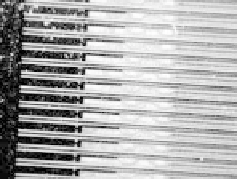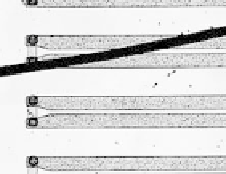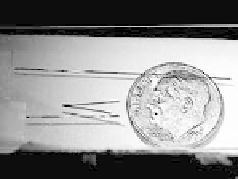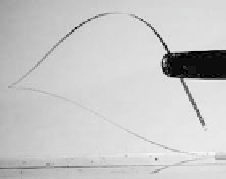Information Technology Reference
In-Depth Information
hair
Electrode
pads
(a)
(b)
(c)
(d)
Figure
16.14.
(a) An array of micro polymer sensors. (b) Magnification of indivi-
dual sensors in relation to a string of hair. The sensing element is embedded in
the tip of the sensor, measured at 200 mm (c) The sensor is flexible, assuming
linear or zigzag fashions. (d) The sensor is folded by a tweezers without
structural or functional damage. The sensor dimension is 4 cm in length,
320 mminwidthand21mm in thickness.
The polymer-embedded sensor enables conformability to the arterial bifurca-
tions and curvatures while retaining its mechanical strength and operational
function. A flexible guide wire is cannulated through the catheter and connected
to the sensing element for transmitting the signal from the vessel to the external
circuitry. The micro intravascular sensors provide an entry point to link spatial and
temporal variations in shear stress and the pathogenesis of coronary artery disease.
It has been also demonstrated that the polymer-based sensor is able to detect
small but distinct temperature perturbation in response to the pulsatile blood flow
in two specific regions of the arterial circulation, namely the abdominal aorta and
aortic arch, in the New Zealand White (NZW) rabbits. Several engineering
challenges have been addressed for in vivo investigation: (1) hemocompatibility
and hemostasis of the sensor function in the rabbit blood; (2) signal-to-noise ratios
and frequency responses under pulsatile arterial blood flow; and (3) novel
packaging technique to transmit voltage signals to the external electronics. The
overall microfabrication process is simple and compatible for both large and small
scale hemodynamics.
16.4.3.2. Integrating the Sensors with Catheters.
The sensors were
packaged to a catheter (Fig. 16.15). The Cr/Au electrode leads were connected
to a guide wire with conductive epoxy (which will cure at 90
1
C in about three














Search WWH ::

Custom Search